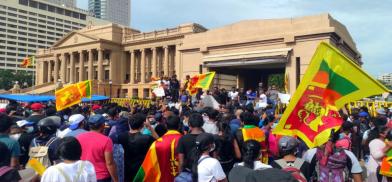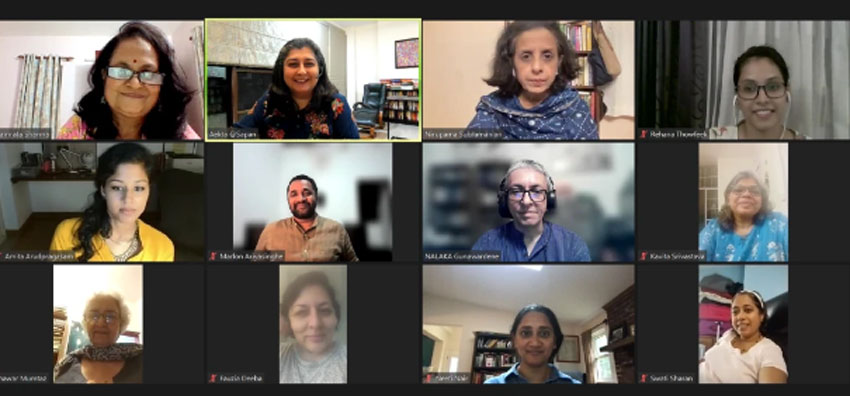Lessons from Sri Lanka: Need for increased governmental accountability and transparency
South Asia must develop a common framework to hold politicians accountable and increase transparency in government dealings. Regional collaboration can reduce vulnerability.

The world watched the economic crisis in Sri Lanka turn into a political one during four months of massive sustained public protests called the Janatha Aragalaya that mushroomed all over Colombo from March to July 2022. Though the crisis continues with protests at a smaller scale, “parachute journalists” from international media are no longer landing here as they were when the movement was at its peak.
Sri Lanka’s nearly 22 million population now faces a humanitarian crisis marked by pervasive hunger, malnutrition, undermined public-health services and record-high inflation. This has led to food insecurity in the most vulnerable coupled with daily load-shedding power cuts as the state-owned electricity utility does not have enough dollars to import fuel for power generation. The country is struggling to import food, medicine, petroleum and other essentials.

What drove Sri Lanka into this abyss? Who is accountable? What is the way out and forward?
A teach-in on Sri Lanka
These questions and more came up in an online discussion titled “Rebuilding Sri Lanka: Reforms or Revolution?” organised by the Southasia Peace Action Network, or Sapan, moderated by award-winning Sri Lankan journalist Nalaka Gunawardene. He was joined by eminent thought leaders, including policy advisor Amita Arudpragasam, economist Rehana Thowfeek and author and editor Marlon Ariyasinghe.
This was Sapan’s first country-focus series, kicked off with Karachi-born Siraj Khan, outgoing president of the Pakistani Association of Greater Boston, presenting the Sapan Founding Charter that calls for a regional approach to all issues and is open for public endorsement. Journalist Sushmita Preetha in Dhaka carried forward Sapan’s ritual of commemorating eminent South Asian personalities with her moving In Memoriam presentation. From Kathmandu, senior Nepali journalist Namrata Sharma hosting the event welcomed participants.
The roots of the crisis lie in the government’s failure to address its fiscal and trade deficits, noted Thowfeek, who has worked with leading think tanks. Simply put, there was more spending than earning, and more imports than exports. A series of bad macroeconomic policy decisions, including tax cuts, made it harder to borrow from international lenders.
Covid-19 lockdowns and production slowdowns compounded the situation. But, as Thowfeek pointed out, the IMF had warned about Sri Lanka’s debt earlier, in the first quarter of 2020, when the effects of the pandemic were still unknown. The country’s credit rating eventually plummeted due to tax cuts and a structured balance-of-payments issue.
Over the past year, the government began borrowing from the Central Bank of Sri Lanka, which started printing more currency without increasing interest rates to adjust the supply. This contributed to inflationary pressures. The currency depreciated further. All this compounded an already grave situation, explained Thowfeek.
International aid: Strings attached
While the proposed nearly three billion dollar International Monetary Fund loan will not ease the pressures on the Lankan economy, the deal signifies that Colombo has managed “to conjure up a plan and put forward a programme credible and sustainable enough to satisfy the IMF”, commented Thowfeek.
International aid came from various quarters, including India, China, Europe and the World Bank. India’s assistance in particular, a USD 4 billion package early in the crisis, led to raised eyebrows: “What is India getting out of this deal or what do they expect? But imagine otherwise… India, the biggest and financially strongest neighbour, doing nothing at all!” observed senior Indian journalist Nirupama Subramanian, who has covered Sri Lanka since 1995.
Suspicions about the big neighbour’s intentions are “an existential concern that stems from a small island country being next to a huge economy,” and also stem from memories of India’s intervention during Sri Lanka’s ethnic conflict, she added.
New Delhi, however, did get something in return. A few doors opened. India’s biggest industrialist, Gautam Adani, won a contract to set up two wind farms in Sri Lanka, replacing the Chinese. Pharma and IT investments are likely to follow. Whether Colombo agrees to these economic inroads is of strategic importance to India.
Did the protests unite a divided society?
While the recent protests are significant, they are certainly not the “longest” in Sri Lanka, noted Arudpragasam, Colombo-based policy advisor and research analyst. The Tamil community primarily in the north and east has been protesting against enforced disappearances for over five-and-a-half years now — more than 2,000 days, and counting.
What was unprecedented about the Aragalaya “was the unprecedented amount of use of the word ‘unprecedented’,” commented Marlon Ariyasinghe who spent months bearing journalistic witness to the Aragalaya.
The island nation is polarised between its north and south, with the north and east initially hesitant about showing solidarity to the south, which has generally not stood with them. The division came to the fore during the Aragalaya protests. However, given their greater levels of poverty, the north and east were as affected by the economic crisis and therefore empathetic to the overall cause, noted Arudpragasam.
At the same time there was “a genuine fear” that members of the minority community participating in protests would be penalised through the Prevention of Terrorism Act (PTA) and other laws as has happened before. Indeed, one of the government’s narratives was that the protests were a conspiracy of the minority community and the diaspora, commented Ariyasinghe, who is also senior assistant editor of Himal Southasian magazine.
Military presence, armed security personnel on motorbikes provoking protestors and action against the Aragalaya gave many in the south a very different image of the security forces than the idealised one they had held.
This suppression was a turning point in the protest as many in the south began questioning the military for the first time. There is a growing realisation about the need to investigate military excesses, including allegations of war crimes, as the north and east have for years been calling for.
There is also a demand to tackle the issue of defence budgeting in Sri Lanka. At present, it is “more than most middle-income countries and much more than some post-conflict countries,” said Arudpragasam, questioning the justification for such military expenditure during peacetime.
Demanding accountability
As in many countries, Sri Lankans tend to become politically active around election time but after that “we immediately go to sleep for the next four-five years”, commented Ariyasinghe.
However, Lankan activists have long been demanding accountability and investigations into the Rajapaksa family’s income. Resignations by themselves do not amount to genuine accountability, as Arudpragasam noted. They are often “a mere tactical retreat”. Deeper institutional reforms are required to counter the entrenched political systems.
There is greater demand from citizens for laws that strip politicians of excessive power and find a way to stop them pulling strings behind the scenes. Not only Sri Lanka, but also most Southasian nations have seen this pattern of cabinet reshuffles, politicians who resign and are re-elected or those who rule through dummy family members when banned from contesting elections. Rarely do power arrangements change, and until they do, all of this is merely theatrical, said Arudpragasam.
There is an important distinction between legal or constitutional legitimacy and popular legitimacy, she added. The current dispensation, elected with a whopping 71% voter turnout, has legal legitimacy and constitutional mandate. They have three years left of their tenure, “But do they have popular legitimacy?” she asked. The crowds pouring onto the streets despite the risk of state repression and huge military presence suggest otherwise.
And yet, “nothing has changed since the composition of parliament hasn’t changed”, as Ariyasinghe commented.
Supporting the case for a fresh mandate, Thowfeek highlighted the lack of effective political alternatives, particularly economic reforms.
The way forward
Can constitutional reforms like elections help the situation as Ariyasinghe suggests, or does Sri Lanka need “Revolution 2.0” that Arudpragasam advocates – massive changes “to ensure we survive these challenges”?
There is general agreement on the responsibility of citizens to vote better “not on the basis of racial identity or handouts but on policies” as Arudpragasam says. She advocates financial support for the emerging young leaders to help them contest elections.
But before that, they need to first “learn to accept criticism and display considerable transparency,” suggests Ariyasinghe. Voter education must include economic education to help citizens understand policy perspectives, said Thowfeek.
Identity is used by politicians globally. “If voters bring up this issue, it would act as a great example to the rest of us in South Asia,” Subramanian noted. Minority communities are “under siege everywhere,” she added. Learning to live together would solve a lot of internal and regional issues. Transparency is key to ensure that no secret arrangements take place. The role of the media is critical here, she said, appreciating Sri Lankan journalists for uncovering scams like the Adani wind farm deal.
There’s also a consensus on the need for decentralisation. “The centralisation of power in one person is deeply problematic. The executive presidency needs to be abolished,” says Arudpragasam.
The virtually overnight decision to ban chemical fertilizers in April 2021, without any prior warning or training, decimated the country’s agricultural sector. It was a presidential decision. Inputs from technocrats and experts urging a reversal “fell on deaf ears… How does a structure allow one man to make such decisions?” Arudpragasam asked.
The president even appoints Sri Lankan monetary board members and the Central Bank governor who is also de-facto chair of the monetary board. The president’s inner circle makes decisions “disregarding actual inputs,” noted Thowfeek.
The discussion also drew attention to the misuse of power by consecutive presidents through the use of the draconian PTA act. There have been dozens of arrests and an ongoing witch hunt for protest organisers including student leaders who are being labelled as fascists. Now, “even public officers are warned against expressing their opinions on social media,” says Ariyasinghe.
Lessons for the region
What are the lessons for South Asian nations? The question from Lahore-based feminist activist Khawar Mumtaz led to a summary of the issues. The crisis in Sri Lanka reminds “the rest of us in South Asia about the potency of people’s power,” commented Nirupama Subramanian in her closing remarks.
Nalaka Gunawardene suggested better documentation of the Sri Lanka story in the form of a book or a long form article — “one that the rest of Southasia can refer to when formulating policies.”
“Pakistan, Bangladesh and Nepal have been saying ‘Don’t be like Sri Lanka’. We have unfortunately become a case study, a cautionary tale,” said Ariyasinghe.
Thowfeek emphasised that people must neither fall for political gimmicks nor vote to concentrate power in the hands of a few.
The most important thing, said Subramanian, is to strengthen people-to-people relationships in the region, building upon the kinship among people, leveraging tourism ties, and establishing media collaborations.
Arudpragasam brought to the fore smaller South Asian countries with similar problems as Sri Lanka: low capital reserves and lack of access to stable economies. South Asia must develop a common framework to hold politicians accountable and increase transparency in government dealings. Regional collaboration can reduce vulnerability.
When democratic institutions are built on the foundation of votes based on identity politics, communalism, and ethnonationalism rather than an evaluation of policy, governance, integrity and political acumen, such crises are but an eventuality. Other nations and international agencies may be able to help the Sri Lankan economy recover, but the systemic and political issues at the root can only be resolved by the citizens themselves. Voters must stay persistent in holding democratic institutions and elected officials accountable.
Until that happens, more of what happened in Sri Lanka awaits across the globe.
(The author is a communications consultant, researcher, and peace activist based in New Delhi. Views are personal. By special arrangement with Sapan)










Post a Comment